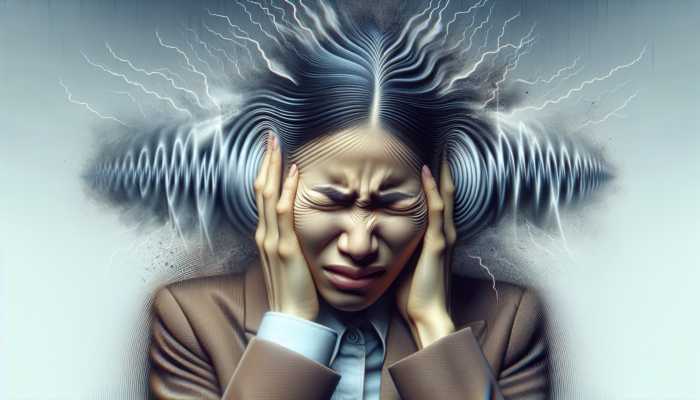Comprehensive Insights into Ear Pressure Changes Due to Weather Conditions
Defining Ear Pressure and Its Effects
Ear pressure refers to an uncomfortable sensation felt within the ears, often described as a feeling of fullness, discomfort, or even pain. This sensation is closely connected to fluctuations in atmospheric pressure, which can occur due to a variety of weather conditions. When the external pressure changes—such as during a storm or a shift in weather patterns—the pressure inside the ear can either increase or decrease, leading to a mismatch that results in discomfort. This phenomenon is particularly pronounced in individuals who are more sensitive to changes in pressure, such as those with pre-existing ear conditions or recent illnesses, making awareness of this connection vital.
Recognizing how weather changes impact ear pressure is essential as it can significantly affect daily life and overall comfort. The Eustachian tube, a critical structure connecting the middle ear to the throat, plays a significant role in regulating ear pressure. It opens and closes during actions like swallowing, yawning, or chewing, allowing air to flow into or out of the middle ear to balance pressure. However, rapid changes in atmospheric pressure can overwhelm this system, leading to discomfort or a sense of fullness. Understanding these dynamics is crucial for managing ear pressure effectively.
Interestingly, ear pressure changes can also influence balance and hearing abilities. When the Eustachian tube fails to equalize pressure efficiently, it may lead to temporary hearing loss or feelings of dizziness. Therefore, it becomes essential for everyone—especially frequent travelers and outdoor enthusiasts—to recognize the signs of changing ear pressure and take proactive measures to manage their symptoms effectively.
The Impact of Weather on Atmospheric Pressure Changes
Weather systems are inherently dynamic and can cause significant fluctuations in atmospheric pressure, which directly influences our ear pressure. High and low-pressure systems function like a giant pump, either compressing air or allowing it to expand, potentially leading to a range of ear-related issues for many people worldwide. For instance, a low-pressure system often signals stormy weather, resulting in decreased pressure that allows outside air to enter the ear more easily, which can create feelings of fullness or discomfort.
Meteorological phenomena such as cyclones, thunderstorms, and even mild seasonal transitions can substantially alter atmospheric pressure. For example, as a storm approaches, the dropping pressure may lead to discomfort in the ears for individuals sensitive to these changes. Conversely, high-pressure systems typically bring clear weather, causing an increase in atmospheric pressure that may alleviate ear pressure discomfort. Being aware of these pressure patterns can empower individuals to prepare for potential discomfort linked to weather changes proactively.
Understanding the relationship between weather and ear pressure can also significantly improve the quality of life for many. For instance, individuals living in coastal regions might experience more pronounced ear pressure changes due to the proximity of large bodies of water, while those in high-altitude areas may face heightened sensitivity. Recognizing these patterns enables people to take preventative actions, such as using decongestants or practicing techniques to equalize ear pressure before uncomfortable weather conditions arise.
The Mechanisms Behind Ear Pressure Changes
At the core of effective ear pressure management lies the Eustachian tube, a small passage linking the throat to the middle ear. Its primary role is to maintain equal pressure on both sides of the eardrum, which is vital for optimal hearing and balance. When weather changes occur, the fluctuation in atmospheric pressure necessitates that the Eustachian tube work diligently to equalize pressure. However, rapid shifts can overwhelm the Eustachian tube’s ability to adapt, resulting in discomfort and pain.
The physiological response to changes in pressure involves a complex interaction of muscles and tissues. The Eustachian tube opens briefly when we swallow or yawn, permitting air to flow in or out of the middle ear. Nevertheless, factors such as nasal congestion, allergies, or infections can hinder this process, creating a bottleneck effect that exacerbates ear pressure issues. This is especially relevant during seasonal allergies, which can cause swelling in nasal passages and complicate the equalization process.
Research indicates that individuals with existing conditions, such as allergies or sinus problems, are particularly vulnerable to the effects of how weather changes influence ear pressure. For instance, the arrival of a cold front could trigger inflammation in the nasal passages, making it increasingly difficult for the Eustachian tube to function correctly. Consequently, these individuals may experience heightened discomfort during weather changes compared to those without such conditions.
To combat these issues, gaining a deeper understanding of the science behind ear pressure changes can lead to effective management strategies. Techniques like the Valsalva maneuver—gently blowing with the nose pinched shut—can help equalize ear pressure. Additionally, methods such as using saline nasal sprays or ensuring adequate hydration can support Eustachian tube function and alleviate discomfort during weather transitions.
Effective Strategies for Managing Ear Pressure During Weather Changes
Effectively managing ear pressure during weather fluctuations is crucial for maintaining comfort and overall well-being. Here are several actionable tips that can significantly improve your experience:
1. Stay Hydrated: Maintaining proper hydration is vital for keeping moisture levels in your mucous membranes, which aids the Eustachian tube in functioning optimally. Drinking plenty of fluids, particularly during significant weather shifts, can help your body adapt to pressure changes more effectively.
2. Practice Techniques for Ear Equalization: Regularly engaging in techniques such as yawning, swallowing, or the Valsalva maneuver can enhance the efficiency with which your Eustachian tubes open and close. These actions facilitate pressure equalization during abrupt weather changes, minimizing discomfort.
3. Utilize Nasal Decongestants: Over-the-counter nasal decongestants can provide relief from nasal congestion, making it easier for the Eustachian tube to operate correctly. However, these should be used cautiously and not for extended periods as they can lead to rebound congestion.
4. Avoid Rapid Altitude Changes: If feasible, avoid sudden changes in altitude, such as flying or driving up steep mountains, during anticipated weather shifts. Planning ahead and considering preventive measures can help mitigate the impact of significant pressure changes.
5. Consult Healthcare Providers: If you’re prone to ear pressure issues during weather changes, discussing this with a healthcare provider may be prudent. They can offer personalized advice and recommend treatments or devices that can help manage discomfort effectively.
By implementing these strategies, individuals can substantially lessen the effects of weather changes on their ear pressure, leading to a more pleasant experience regardless of external conditions. Gaining a better understanding of how external factors influence our bodies allows us to take control and live comfortably alongside nature.
The Relationship Between Common Weather Conditions and Ear Pressure
Understanding High and Low-Pressure Systems
Weather systems are primary contributors to fluctuations in ear pressure. High and low-pressure systems create a dynamic environment that can significantly affect ear pressure. High-pressure systems generally bring clear skies and stable weather, resulting in an increase in atmospheric pressure. This increase often leads to a decrease in ear pressure, providing relief for individuals who experience discomfort during low-pressure conditions.
Conversely, low-pressure systems are frequently associated with stormy weather, bringing clouds, rain, and often a drop in atmospheric pressure. This decrease can create a feeling of fullness in the ears, as the external pressure becomes less than the pressure inside the middle ear. For those sensitive to these changes, this can result in discomfort or pain. Understanding these dynamics is essential, especially for residents in areas prone to rapid weather fluctuations or extreme weather events.
Individuals who frequently travel or engage in outdoor activities must remain vigilant about the potential for ear pressure changes linked to weather systems. For example, mountain climbers or hikers may feel the effects of dropping atmospheric pressure as they ascend, leading to ear discomfort. Similarly, those living near coastal regions might encounter significant pressure changes with the approach of storms.
Keeping an eye on local weather reports and being aware of pressure changes can empower individuals to take proactive measures to alleviate ear pressure discomfort. For instance, those anticipating a storm might practice ear equalization techniques in advance or ensure they remain hydrated to support the function of their Eustachian tubes.
In summary, understanding the relationship between atmospheric pressure systems and ear pressure dynamics is vital for anyone looking to maintain comfort during varying weather conditions.
How Temperature Changes Affect Ear Pressure
Temperature fluctuations are another critical factor influencing ear pressure and overall ear health. Rapid temperature changes can lead to corresponding shifts in atmospheric pressure, causing the pressure inside the ear to become unbalanced. For example, when a cold front arrives, the drop in temperature often accompanies a decrease in atmospheric pressure, resulting in increased discomfort for many individuals.
This phenomenon is particularly pronounced during transitional seasons, such as autumn and spring, when temperatures can swing significantly within a single day. For instance, a sunny morning can quickly turn into a chilly afternoon, leading to abrupt pressure changes that may affect the ears. The body’s natural ability to regulate internal pressure may struggle to keep pace with such rapid changes, resulting in symptoms like fullness, popping, or pain.
In urban environments, where heat islands can create localized temperature shifts, residents might experience more pronounced ear pressure fluctuations. For example, a sudden downpour following a warm spell can lead to significant temperature drops, potentially causing discomfort for those sensitive to ear pressure changes.
To mitigate the effects of temperature changes on ear pressure, it is essential to take proactive measures. When facing significant temperature shifts, staying indoors when possible can allow your body time to acclimate to the new conditions. Additionally, practicing techniques to equalize ear pressure can be beneficial during these transitions.
Being aware of how temperature variations impact ear pressure can help individuals prepare for discomfort and take proactive steps to maintain ear health.
The Influence of Humidity on Ear Pressure
Humidity plays a crucial role in how weather changes affect ear pressure. High humidity levels can intensify discomfort experienced during pressure fluctuations. For example, when the air is saturated with moisture, it can create a feeling of heaviness in the atmosphere, which may lead to increased pressure in the ears. This is especially evident in tropical climates where humidity levels remain consistently high, making it challenging for the body to adapt to pressure changes.
High humidity can also lead to increased ear-related issues such as congestion, directly affecting the Eustachian tube’s ability to equalize pressure. Swelling of nasal passages due to humidity can lead to blockages, preventing proper airflow and pressure regulation within the ear. Consequently, individuals may experience greater discomfort during weather changes when humidity is a contributing factor.
Conversely, low humidity can lead to dry air that irritates the mucous membranes in the nasal passages and throat, potentially restricting the Eustachian tube’s function. This duality highlights the importance of understanding not only how weather changes affect ear pressure in terms of temperature but also the significant role humidity plays in this equation.
Reducing the effects of humidity on ear pressure can be achieved by using humidifiers in dry conditions to maintain moisture levels in the air or dehumidifiers in excessively humid conditions to help alleviate congestion. Monitoring local humidity levels and adjusting your environment can greatly benefit those sensitive to ear pressure fluctuations.
Ultimately, recognizing the intricate connection between humidity, atmospheric pressure, and ear health is essential for anyone aiming to maintain comfort during varying weather conditions.
Altitude Changes and Their Effect on Ear Pressure
Changes in altitude can lead to some of the most immediate impacts on ear pressure. As elevation increases, the atmospheric pressure decreases, resulting in a sensation in the ears often referred to as “ear popping.” This phenomenon occurs because the pressure in the middle ear is greater than the external pressure, necessitating equalization. For travelers, hikers, or those living in mountainous regions, understanding this relationship is critical for maintaining comfort during altitude changes.
Experiencing fullness or discomfort in the ears during altitude changes is primarily due to the Eustachian tube’s inability to balance pressure quickly enough. For example, during a flight, as the airplane ascends, the rapid decrease in atmospheric pressure can lead to discomfort for passengers, especially if they cannot equalize the pressure in their ears effectively. Techniques such as swallowing, yawning, or performing the Valsalva maneuver can be highly effective in alleviating this discomfort.
In scenarios where individuals ascend rapidly, such as during mountain hikes or skiing, the risk of ear pain increases. Pressure changes can be more pronounced for those with allergies, colds, or sinus issues, making it vital for them to take precautions before heading to higher altitudes. Staying hydrated, utilizing nasal sprays, and practicing equalization techniques can greatly enhance comfort levels and prevent ear pressure discomfort.
Furthermore, understanding the effects of altitude on ear pressure can help adventurers and travelers make informed decisions about their activities. For instance, taking gradual ascents and allowing time for the body to adjust can prevent sudden ear pressure issues. This awareness can enhance overall experiences, enabling individuals to enjoy their adventures without the encumbrance of ear discomfort.
In summary, altitude changes present unique challenges regarding ear pressure. Recognizing this can inspire proactive measures that allow individuals to navigate both everyday activities and exciting adventures comfortably.
The Effects of Wind on Ear Pressure
Strong winds can create pressure variations that have a surprisingly significant impact on ear pressure. When gusts of wind blow, they can cause localized changes in atmospheric pressure, leading to discomfort for individuals who are already sensitive to such fluctuations. For example, wind can disrupt the balance of pressure in the ear, resulting in sensations of fullness or pain, especially for those with pre-existing ear issues.
Individuals participating in outdoor activities, such as sailing or biking, may experience these symptoms firsthand. The force of the wind can create a noticeable difference in pressure between the outer ear and the middle ear, complicating the body’s natural attempts to equalize pressure. This experience can be particularly uncomfortable on windy days, especially in exposed areas like beaches or mountains.
Moreover, the relationship between wind and ear pressure extends beyond discomfort; it can also affect hearing. Wind noise can interfere with auditory clarity, making it difficult to hear conversations or sounds in nature. For those who rely on clear hearing for safety—such as cyclists or hikers—this can pose a significant concern.
To manage the effects of wind on ear pressure, individuals can implement several proactive measures. Utilizing earplugs designed for wind protection can help mitigate the impact of strong gusts while reducing discomfort. Additionally, staying informed about weather conditions and planning outdoor activities accordingly can help individuals avoid excessive exposure to windy conditions.
In essence, recognizing the impact of wind on ear pressure empowers individuals to take steps to remain comfortable and safe while enjoying outdoor pursuits. Awareness and preparedness can significantly enhance the experience of navigating the challenges posed by changing weather conditions.
Identifying Symptoms and Effects of Weather-Related Ear Pressure Changes
Recognizing Common Symptoms of Ear Pressure Changes
Experiencing changes in ear pressure can manifest through a range of uncomfortable symptoms. The most common experiences include ear pain, a sensation of fullness, and popping sounds within the ear. Each of these symptoms signals that the body is struggling to equalize pressure within the ear, often due to rapid weather changes or fluctuations in atmospheric pressure.
Ear pain is perhaps the most distressing symptom, ranging from mild discomfort to sharp pain that disrupts daily activities. This sensation often intensifies during weather transitions, such as when a storm approaches or during travel at high altitudes. The pain is frequently a consequence of pressure build-up or sudden shifts that the Eustachian tube cannot manage effectively.
Additionally, individuals may experience a feeling of fullness in the ears, akin to the sensation one feels when descending from a flight or driving in mountainous terrain. This fullness can lead to a sense of imbalance, making it challenging to concentrate or engage in activities requiring focus.
Lastly, popping sounds can occur as the Eustachian tube attempts to equalize pressure. While this sensation may provide temporary relief, it can also be unsettling, particularly for those unaccustomed to experiencing ear pressure changes. Recognizing these symptoms is crucial for implementing proactive measures to alleviate discomfort effectively.
Understanding the common symptoms associated with ear pressure changes empowers individuals to address their concerns proactively. By monitoring their bodies and recognizing when these symptoms arise, individuals can implement strategies to manage discomfort and maintain a high quality of life.
Long-Term Effects of Frequent Ear Pressure Changes
Frequent changes in ear pressure can result in significant long-term effects on ear health. One of the most concerning outcomes is the potential development of chronic ear issues, such as tinnitus or hearing loss. Tinnitus, characterized by constant ringing or buzzing in the ears, can be exacerbated by repeated pressure changes, leading to heightened sensitivity to sounds and discomfort in daily life.
Chronic exposure to pressure changes can also impact the structure of the ear itself. Over time, the Eustachian tube may become less effective at equalizing pressure, resulting in a cycle of discomfort that becomes increasingly challenging to manage. Individuals who experience persistent ear pressure changes may find themselves more susceptible to infections or other complications, further complicating their ear health.
Moreover, individuals with pre-existing ear conditions may find that frequent pressure changes exacerbate their symptoms, leading to a decline in overall ear health. For example, individuals with a history of ear infections may experience more frequent episodes due to the challenges posed by fluctuating pressure. Similarly, those with auditory issues may find that pressure changes worsen their symptoms, leading to reluctance to engage in activities that could trigger discomfort.
Addressing these long-term effects begins with awareness and proactive action. Individuals prone to ear pressure changes should consult healthcare providers for personalized strategies to manage their symptoms and protect their ear health. Developing a proactive approach can help mitigate the impact of frequent pressure changes and promote long-term well-being.
Identifying When to Seek Medical Attention
While many people experience occasional discomfort due to ear pressure changes, specific instances necessitate medical attention. If symptoms persist, intensify, or are accompanied by severe pain or hearing loss, seeking help from a healthcare provider is crucial. These can be signs of underlying conditions that require professional evaluation and intervention.
Particularly, individuals experiencing debilitating pain should not hesitate to consult a medical professional. Persistent ear pressure changes can indicate complications like infections, fluid build-up, or other issues that may not resolve without medical intervention. Additionally, if symptoms are accompanied by dizziness or balance issues, this may signal that the inner ear is affected, warranting immediate attention.
For individuals with a history of ear problems or those prone to recurrent ear infections, regular check-ups with an otolaryngologist may be beneficial. This proactive approach can ensure that any potential issues are identified early, allowing for timely treatment and preventing further complications.
Recognizing when to seek medical attention can make a significant difference in managing ear pressure discomfort effectively. By being vigilant and informed, individuals can take control of their ear health and ensure they receive the necessary care.
Strategies for Managing Ear Pressure During Weather Changes
Techniques to Alleviate Ear Pressure
Individuals experiencing discomfort from ear pressure changes can utilize various effective techniques to alleviate symptoms. Understanding and practicing these methods can lead to immediate relief and improved comfort when facing fluctuating weather conditions.
One of the simplest yet most effective techniques is swallowing. When we swallow, the Eustachian tube opens momentarily, allowing air to equalize pressure in the middle ear. Chewing gum or sucking on hard candy can stimulate this reflex, making it an easy and accessible option for those experiencing ear pressure discomfort.
Yawning stands out as another valuable technique for relieving ear pressure. Yawning opens the Eustachian tubes and helps stretch the surrounding muscles, allowing for better pressure equalization. Individuals can induce yawning by simply opening their mouths wide, which can provide quick relief.
For those interested in a more targeted approach, the Valsalva maneuver is a well-known method. This technique involves pinching the nose shut and gently blowing, forcing air into the Eustachian tubes and assisting in equalizing pressure. However, individuals should exercise caution when using this method, avoiding excessive force, as too much pressure can result in further discomfort.
In addition to these techniques, staying well-hydrated is crucial for maintaining proper mucous membrane function, which supports the Eustachian tubes in managing ear pressure. Incorporating these simple yet effective techniques into daily routines can significantly enhance comfort during weather changes, empowering individuals to navigate fluctuations in ear pressure confidently.
Preventive Strategies for Ear Pressure Management
Preventing ear pressure issues during weather changes begins with a thorough understanding of the factors contributing to discomfort. By implementing a few proactive measures, individuals can minimize the likelihood of experiencing ear pressure changes and improve their overall comfort.
One of the most effective preventive strategies is staying hydrated. Proper hydration helps maintain moisture levels in mucous membranes, supporting the Eustachian tubes’ ability to function effectively. Drinking ample fluids, especially before and during significant weather changes, plays a pivotal role in ear health.
Moreover, avoiding sudden altitude changes can help minimize ear pressure discomfort. When flying or hiking, individuals can take gradual ascents to allow the body time to acclimate to pressure changes. If traveling by air, using decongestants or nasal sprays before takeoff and landing can aid in keeping the Eustachian tubes clear, facilitating easier pressure equalization.
Regularly practicing ear equalization techniques, such as yawning and swallowing, can also help prepare the ears for fluctuating pressure. By making these techniques a habitual practice, individuals can significantly reduce discomfort when faced with sudden weather changes.
Finally, individuals with pre-existing ear conditions should be particularly vigilant. Consulting with a healthcare provider about specific preventive strategies tailored to individual needs can enhance ear health and comfort during weather changes.
Implementing these preventive measures can empower individuals to take control of their ear health, ensuring a more comfortable experience during weather fluctuations.
Products and Devices for Effective Ear Pressure Relief
For individuals struggling with ear pressure changes, a variety of products and devices can provide significant relief. These tools can enhance comfort during weather fluctuations and simplify the management of ear pressure.
One common product is pressure-equalizing earplugs. These specially designed earplugs help regulate pressure in the ears by allowing air to flow in and out while blocking external sound. They are particularly beneficial for frequent travelers and individuals susceptible to discomfort during flights or changes in elevation.
Another useful device is nasal saline spray, which helps keep nasal passages moist and reduces congestion. Keeping nasal passages clear can facilitate better Eustachian tube function, making it easier to equalize pressure in the ears during weather changes.
For those interested in more advanced solutions, devices that utilize vibration or sound therapy may provide effective relief. These devices work by stimulating the Eustachian tubes and promoting pressure equalization, potentially enhancing comfort for individuals facing frequent ear pressure changes.
Additionally, consulting with a healthcare provider about prescription medications or treatments can offer tailored solutions for effective ear pressure management. By exploring available products and devices, individuals can find the right combination of tools to support their ear health and comfort during weather fluctuations.
In summary, understanding the options for ear pressure relief can empower individuals to navigate the challenges posed by changing weather conditions effectively.
Special Considerations for Sensitive Groups
Addressing Ear Pressure Sensitivity in Children
Children are particularly sensitive to ear pressure changes due to anatomical differences, such as smaller Eustachian tubes. This increased sensitivity can lead to discomfort or pain during rapid pressure changes, making it essential for parents and caregivers to recognize the potential impact of weather on ear health.
When facing pressure changes, children may struggle to communicate their discomfort effectively, leading to frustration and anxiety. Symptoms such as fussiness, ear-pulling, or difficulty sleeping can indicate that a child is experiencing ear pressure issues. Recognizing these signs empowers parents to take proactive measures to alleviate discomfort.
To support children during weather changes, parents can encourage hydration and teach them simple techniques for equalizing ear pressure, such as yawning or swallowing. Offering chewy snacks or gum can also stimulate the swallowing reflex, promoting pressure equalization.
Monitoring weather conditions and planning activities accordingly can further support children’s ear health. For instance, avoiding outdoor play during significant weather shifts or ensuring that children are prepared with appropriate ear protection during windy or stormy conditions can greatly enhance their comfort and reduce ear pressure issues.
By understanding the unique challenges that children face regarding ear pressure changes, parents and caregivers can provide effective support, ensuring kids remain comfortable and happy, regardless of the weather.
Understanding Ear Pressure Challenges in the Elderly
The elderly population often encounters unique challenges related to ear pressure changes, primarily due to age-related changes in anatomy and physiology. As individuals age, the Eustachian tube may become less flexible, making it more difficult to equalize ear pressure effectively. This can lead to increased discomfort during weather changes, significantly impacting quality of life.
Elderly individuals may also experience a decline in hearing sensitivity, which can further complicate the discomfort caused by fluctuating ear pressure. Symptoms such as ear pain, fullness, or popping may be exacerbated by existing ear conditions, making it essential for older adults to be aware of the potential impact of weather on their ear health.
To support ear health in the elderly, promoting proactive management strategies is vital. Encouraging regular hydration can help maintain mucous membrane function, supporting the Eustachian tube in equalizing pressure. Additionally, ensuring that elderly individuals are familiar with simple techniques for ear pressure relief, such as yawning or using nasal sprays, can empower them to manage their symptoms effectively.
Regular check-ups with healthcare providers can also enhance ear health among the elderly. By addressing ear pressure concerns early and discussing potential treatments or preventive measures, healthcare providers can help older adults maintain comfort and quality of life.
In summary, understanding the unique considerations of the elderly regarding ear pressure changes can lead to effective support and management strategies, ensuring they remain comfortable and healthy.
Managing Ear Pressure for Individuals with Pre-Existing Conditions
For individuals with pre-existing ear conditions, managing ear pressure during weather changes can be particularly challenging. Conditions such as chronic ear infections, Eustachian tube dysfunction, or hearing loss may heighten sensitivity to fluctuations in atmospheric pressure, leading to increased discomfort.
Recognizing the potential impact of weather on existing ear issues is crucial for these individuals. Symptoms like ear pain, fullness, or popping may become more pronounced during weather changes, making proactive management strategies essential. Consulting with healthcare providers for personalized strategies tailored to individual needs can significantly enhance ear health and comfort.
In addition to regular check-ups, individuals with pre-existing ear conditions can benefit from maintaining a consistent routine for ear pressure management. This may include practicing equalization techniques, staying well-hydrated, and using appropriate nasal sprays to keep passages clear. By developing a comprehensive approach to managing ear pressure, individuals can navigate weather changes more comfortably.
Furthermore, monitoring weather patterns and being aware of impending changes can empower those with pre-existing conditions to take preventive measures. For instance, if a storm is forecasted, individuals can prepare by ensuring they have necessary relief products on hand and employing techniques to manage potential discomfort.
Ultimately, understanding the unique challenges faced by individuals with existing ear conditions can help foster a proactive approach to ear health, ensuring comfort during weather fluctuations.
Ear Pressure Sensitivity in Pregnant Women
Pregnant women may experience heightened sensitivity to ear pressure changes due to hormonal fluctuations affecting Eustachian tube function. During pregnancy, increased levels of estrogen and progesterone can lead to swelling of the mucous membranes, making it more challenging for the body to equalize ear pressure effectively. As a result, pregnant women may find themselves dealing with discomfort during weather changes that would not typically affect them.
Recognizing the potential for increased ear pressure sensitivity can help pregnant women take proactive steps to manage their symptoms. Staying well-hydrated is crucial, as proper hydration can help maintain moisture levels in mucous membranes, supporting ear function. Additionally, practicing ear equalization techniques, such as yawning or swallowing, can promote comfort during pressure changes.
Pregnant women should also be mindful of their environment, particularly when weather conditions shift dramatically. It may be wise to avoid exposure to extreme temperatures or weather conditions known to exacerbate ear pressure discomfort.
Consulting with healthcare providers can provide pregnant women with personalized recommendations for managing ear pressure changes effectively. By understanding the unique challenges they face, pregnant women can navigate weather fluctuations more comfortably and maintain their overall well-being.
Addressing Ear Pressure Changes for Individuals with Respiratory Allergies
For individuals with respiratory allergies, the impact of weather changes on ear pressure can be particularly pronounced. Allergies can lead to nasal congestion and inflammation, making it more difficult for the Eustachian tube to function properly. This congestion can create a bottleneck effect, exacerbating ear pressure discomfort during weather fluctuations.
Recognizing the connection between allergies and ear pressure issues is crucial for effective management. Individuals with respiratory allergies should take proactive measures to keep nasal passages clear, especially during significant weather changes. Utilizing saline nasal sprays, staying hydrated, and avoiding allergens can all support ear health and minimize discomfort.
Additionally, practicing ear equalization techniques can help individuals manage their symptoms effectively. Simple actions such as swallowing, yawning, or using the Valsalva maneuver can promote pressure equalization and alleviate discomfort associated with allergies during weather transitions.
Consulting with healthcare providers about allergy management strategies can also be beneficial for individuals facing ear pressure challenges. By addressing the underlying causes of allergies, individuals can improve their overall quality of life and reduce the impact of weather changes on ear pressure.
Ultimately, understanding the interplay between respiratory allergies and ear pressure can empower individuals to take control of their ear health, ensuring comfort and well-being during fluctuating weather conditions.
Future Directions in Research and Understanding
Investigating Weather Patterns and Ear Pressure Changes
Ongoing research continues to explore the intricate relationship between weather patterns and ear pressure changes. Studies aim to deepen our understanding of how atmospheric conditions, such as humidity, temperature, and pressure systems, influence ear health and comfort. These insights can lead to improved preventive measures and treatment options for individuals prone to ear pressure discomfort.
Recent studies emphasize the importance of considering individual variability in responses to weather changes. Factors such as genetic predisposition, pre-existing ear conditions, and environmental influences can all significantly influence how a person experiences ear pressure changes. Understanding these variables can lead to more personalized approaches to ear health management.
Additionally, researchers are examining how weather-related factors can influence the prevalence of ear infections and other ear-related issues. By establishing clear links between weather patterns and ear health outcomes, researchers aim to provide actionable insights that can enhance preventive care and treatment options for individuals experiencing ear pressure changes.
As research progresses, it may pave the way for enhanced public health initiatives focused on educating individuals about the impact of weather on ear pressure. By raising awareness of these connections, healthcare providers can better equip individuals with the knowledge and tools to manage their ear health effectively.
Technological Innovations in Ear Pressure Management
Technological advancements are transforming how individuals manage ear pressure changes related to weather fluctuations. New devices and applications are being developed to provide real-time monitoring of environmental conditions, allowing individuals to anticipate potential ear pressure issues before they arise.
For example, wearable technology is being designed to monitor atmospheric pressure and alert users to significant changes that may impact ear health. This proactive approach enables individuals to take preventive measures, such as practicing ear equalization techniques or using pressure-equalizing earplugs ahead of time.
Moreover, advancements in telemedicine are making it easier for individuals to consult with healthcare providers about their ear pressure concerns. Virtual consultations enable individuals to receive personalized advice and treatment options without the need for in-person visits, enhancing accessibility to care.
Innovative products, such as pressure-equalizing devices that utilize vibrations or sound therapy, are also gaining popularity. These devices aim to stimulate the Eustachian tubes and promote pressure equalization, potentially improving comfort for individuals dealing with frequent ear pressure changes.
As technology evolves, it holds the potential to substantially enhance the management of ear pressure issues, empowering individuals to navigate the challenges posed by fluctuating weather conditions more effectively.
Enhancing Public Awareness and Education Initiatives
Increasing public awareness of the connection between weather changes and ear pressure is essential for promoting ear health. Educational campaigns can empower individuals with the knowledge and skills necessary to manage their symptoms effectively, ensuring they remain comfortable during fluctuations in atmospheric conditions.
Healthcare providers play a pivotal role in disseminating information about ear pressure management. By raising awareness among patients about the potential impacts of weather on ear health, providers can assist individuals in recognizing symptoms early and taking proactive measures to alleviate discomfort.
Additionally, community outreach programs can offer valuable resources and support for individuals facing ear pressure issues. Workshops, informational sessions, and distribution of educational materials can equip individuals with the knowledge they need to navigate weather changes comfortably.
Collaborative efforts between healthcare providers, meteorologists, and public health organizations can further enhance awareness and understanding of the relationship between weather and ear pressure. By working together, these entities can develop comprehensive educational initiatives that reach diverse populations and promote ear health.
Ultimately, fostering public awareness of the links between weather changes and ear pressure can lead to improved quality of life for individuals susceptible to ear pressure discomfort. With the right knowledge and support, individuals can take control of their ear health and navigate changing weather conditions with confidence.
Collaborative Research Approaches
Collaborative research initiatives between meteorologists and otolaryngologists are enhancing our understanding of the dynamics between weather and ear pressure. By combining expertise from both fields, researchers can investigate how atmospheric conditions influence ear health and develop effective management strategies.
These collaborative efforts aim to uncover the mechanisms behind ear pressure changes and identify factors that contribute to sensitivity among different populations. By examining data on weather patterns and correlating it with ear health outcomes, researchers can provide valuable insights that inform preventive care and treatment options.
Moreover, interdisciplinary research can facilitate the development of innovative technologies and tools for managing ear pressure issues. By harnessing insights from meteorology, audiology, and public health, researchers can create comprehensive solutions that address the complexities of ear pressure management.
As these collaborative efforts progress, they hold the promise of advancing our understanding of ear health in relation to weather changes. By uncovering the intricacies of this relationship, researchers can pave the way for improved public health initiatives and personalized care strategies for individuals experiencing ear pressure discomfort.
Frequently Asked Questions about Ear Pressure and Weather Changes
What causes ear pressure changes during weather fluctuations?
Ear pressure changes occur due to fluctuations in atmospheric pressure, often triggered by weather systems like storms or changes in temperature and humidity.
How can I relieve ear pressure at home?
Home remedies include yawning, swallowing, practicing the Valsalva maneuver, and staying hydrated to help equalize pressure in the ears.
Are children more susceptible to ear pressure changes?
Yes, due to their smaller Eustachian tubes, children are often more sensitive to ear pressure changes, leading to discomfort during rapid weather shifts.
When should I consult a doctor for ear pressure issues?
Seek medical attention if ear pressure discomfort persists, intensifies, or is accompanied by severe pain or hearing loss.
Can altitude changes affect ear pressure?
Yes, altitude changes lead to significant shifts in atmospheric pressure, which can cause discomfort and require pressure equalization techniques.
How do humidity levels impact ear pressure?
High humidity can exacerbate ear pressure issues by causing nasal congestion, making it difficult for the Eustachian tube to equalize pressure effectively.
What preventive measures can I take for ear pressure discomfort?
Preventive measures include staying hydrated, avoiding sudden altitude changes, and regularly practicing ear equalization techniques.
Are there products available for ear pressure relief?
Yes, pressure-equalizing earplugs, nasal saline sprays, and vibration therapy devices can provide relief from ear pressure discomfort.
How can pregnant women manage ear pressure changes?
Pregnant women can manage ear pressure by staying hydrated, using nasal sprays, and practicing equalization techniques to mitigate discomfort.
What is the relationship between allergies and ear pressure changes?
Respiratory allergies can lead to nasal congestion, making it difficult for the Eustachian tube to function properly, exacerbating ear pressure discomfort.
The post Weather Changes and Their Impact on Ear Pressure: A Guide appeared first on The Microsuction Ear Wax Removal Network.


























